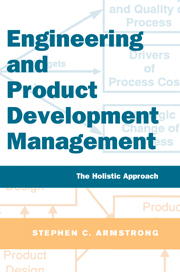Book contents
- Frontmatter
- Contents
- List of figures and tables
- Forewords
- Preface
- Acknowledgments
- Layout of book at a glance
- PART 1 UNDERSTANDING ENGINEERING PROCESS MANAGEMENT
- PART 2 APPLYING ENGINEERING PROCESSES TO PROGRAM MANAGEMENT
- PART 3 DEPLOYING ENGINEERING PROCESS MANAGEMENT
- PART 4 APPENDIXES
- A IPD maturity self-evaluation tools
- B Chapter 2 tables
- C Chapter 3 table
- D Pogram structuring and planning checklist
- E Chapter 8 tables
- F Understanding the ERP and the PDM connection
- Glossary
- References
- Index
F - Understanding the ERP and the PDM connection
Published online by Cambridge University Press: 05 April 2014
- Frontmatter
- Contents
- List of figures and tables
- Forewords
- Preface
- Acknowledgments
- Layout of book at a glance
- PART 1 UNDERSTANDING ENGINEERING PROCESS MANAGEMENT
- PART 2 APPLYING ENGINEERING PROCESSES TO PROGRAM MANAGEMENT
- PART 3 DEPLOYING ENGINEERING PROCESS MANAGEMENT
- PART 4 APPENDIXES
- A IPD maturity self-evaluation tools
- B Chapter 2 tables
- C Chapter 3 table
- D Pogram structuring and planning checklist
- E Chapter 8 tables
- F Understanding the ERP and the PDM connection
- Glossary
- References
- Index
Summary
ERP and PDM have different origins and different purposes.
MRP (materials requirements planning) came into being in the 1960s as a methodology or practice for maximizing the efficiency of production through production schedules and inventory control. Even though the definition has evolved with the addition of financial information to MRP II to ERP (enterprise resource planning), the basic functions remain the same – tell me how much inventory and manufacturing resources I will need to produce x amount of product over y period.
MRP software systems evolved to handle the large amounts of data and the complex calculations required to answer this question. They have served as planning tools for production, and accounting tools for reporting inventory status. The late Oliver Wight led the MRP II crusade in the United States beginning in the early 1980s. Practically all ERP gurus today learned the ERP body of knowledge through APICSand “Olie” Wight.
PDM (product data management) came into being in the early 1980s, originally as a means to manage engineering documentation. It offered a number of new concepts just now emerging as mainstream capabilities for general use, such as document management, workflow, and distributed repositories. These “services” were put together to answer questions such as:
❍ What does the configuration for the current active revision look like?
❍ What did the prior revision of this product look like?
❍ What changed between that revision and the current one?
❍ How many engineering change orders are outstanding against this product?
- Type
- Chapter
- Information
- Engineering and Product Development ManagementThe Holistic Approach, pp. 301 - 310Publisher: Cambridge University PressPrint publication year: 2001



